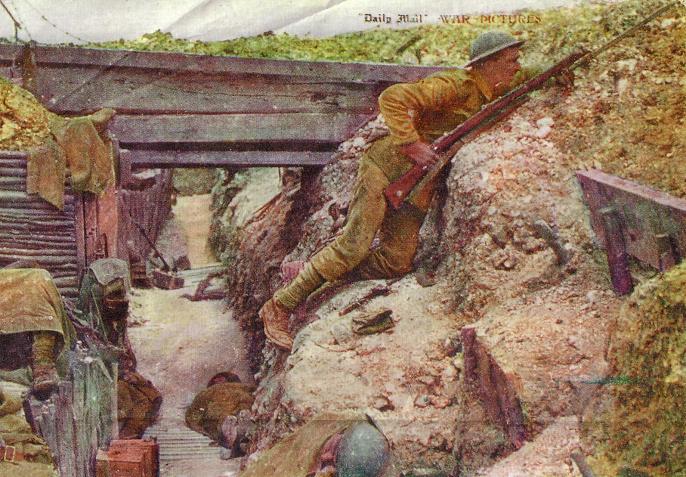A captured trench
This photograph and caption appeared in
the Daily Mail Weekend magazine in 2007

This picture shows a British soldier with rifle and fixed
bayonet guarding a captured German trench near the village of La Boiselle at
the beginning of the bloody Battle of the Somme on 1st July 1916. Exhausted,
dead, or wounded comrades are clearly visible behind him. The Somme was a
British offensive that achieved almost none of its initial objectives, and
the 1st of July was the bloodiest day in British military history. It is now
a byword for the futile attacks, long casualty lists, courage - but also
incompetence - that today represent our image of the war. Sadly, the few
British gains that were made on the first day of the Somme were not retained
and this trench was probably retaken in a German counterattack the same day.
When the battle was finally halted in mid-November, British Empire
casualties totalled 450,000; the Germans lost a similar number, and the
French 250,000. German trenches were dug more deeply and fortified more
heavily than their British equivalents as the Germans adopted a defensive
strategy on the Western Front, with the Allies doing most of the attacking.
These deep dugouts, often fortified with wood or reinforced concrete,
allowed the Germans to `sit out' the million or more British shells that
were fired in the week leading up to the Somme attack. Class divisions
prevailed in British trenches, with private soldiers sleeping in the open,
while the officers enjoyed the relative comfort and protection of `dugouts'.
Regulation British trenches were dug seven feet deep, topped by sandbags,
and had barbed-wire entanglements in the No Man's Land between them and the
German front lines. The British trench lines wound for some 450 miles from
the Channel at Nieuport in Belgium to below the French town of St Quentin.
Depending on the landscape, they could be as close as 30 yards from the
enemy, or as far as half a mile away. Although the trench lines moved a few
miles in each direction during major offensives, the basic front lines
remained static for four years from autumn 1914 to autumn 1918. |
|